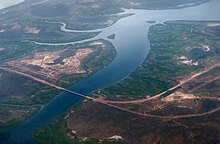Darwin Harbour


Darwin Harbour is a body of water close to the city of Darwin in the Northern Territory of Australia. It is the traditional waterways of the Larrakia people.[1]
It opens to the north at a line from Charles Point in the west to Lee Point in the east into the Beagle Gulf and connects via the Clarence Strait with the Van Diemen Gulf.[2] It contains Port Darwin, which is flanked by Frances Bay to the east and Cullen Bay to the west.
History
The Larrakia people are the Traditional Owners of Darwin Harbour who used canoes to navigate its waterway for fishing, trading and cultural purposes.[3][4]
Despite having never visited the area, Darwin Harbour was named after naturalist Charles Darwin. It was named by his friend and former shipmate Lieutenant John Lort Stokes during HMS Beagle's third expedition on 9 September 1839.[5]
Ships in Darwin Harbour were heavily bombed by the Japanese during World War II in February 1942, leaving numerous wrecks that were eventually salvaged up in the 1960s.[6]
Climate
The climate of the Darwin Harbour region is monsoon tropical with two distinct seasons: the Dry and the Wet. The Dry lasts for 6 months between April and September with an average rainfall of 24 mm, whereas the Wet lasts between October and March with an average monthly rainfall of 254 mm/month (according to the Bureau of Meteorology, 1999). The majority of the rain falls between December and April. Runoff varies between 250–1000 mm. Riverine discharge is relatively low with the exception of the Blackmore River and Elizabeth River. Peak flow for these rivers occurs in February, respectively 605Ml/day and 389 Ml/day, after which it slowly decreases until July when there is no freshwater input into Darwin Harbour until the onset of the following wet season (Padovan 1997). Cyclone frequency is low to moderate.[2]
Marine life
Darwin Harbour supports very high fish diversity with 415 fish species now known. Darwin Harbour provides a unique opportunity to see dugongs in the wild, because their favourite food is located off Casuarina and Bundilla (formerly Vesteys)[7] beaches. Seagrass meadows are also the main diet of green turtles and provide habitats for many smaller marine animals including commercially important species such as prawns and fish.[8]
Oceanography
Currents
The tides at Port Darwin are macro-tidal with a maximum tidal range of 7.8 m, a mean spring range of 5.5 m and a mean neap range of 1.9 m (Padovan, 1997). The currents caused by these tides are complex and strong.[2]
Estuaries

Darwin Harbour is a drowned river valley and consist of ria shorelines and extensive headlands.[2]
Catchment
The catchment of Darwin Harbour occupies a total area of approximately 3,230 square kilometres (1,247 sq mi), of this 2,010 square kilometres (776 sq mi) is land based and the other 1,220 square kilometres (471 sq mi) are estuarine areas at the high water mark.[9]
Geology
The underlying lithology is dominated by Permian siltstones and sandstones.[2]
Administrative status
On 4 April 2007, the remainder of Darwin Harbour which was not already part of a suburb or a locality within the boundaries of either of the two local government areas, the City of Darwin and the Litchfield Municipality, was gazetted by the Northern Territory Government as a locality with the name, Darwin Harbour. Its north-western boundary aligns with that of the boundary for the Port of Darwin which extends from Charles Point in the west to Lee Point in the east.[10][11] The locality has not been added to any existing local government area and is considered to be part of the Northern Territory's unincorporated areas.[12]
See also
References
- ^ "'They need to be protected at all costs': Traditional owners fear for cultural sites at $1.5 billion industrial hub". ABC News. 11 May 2023. Retrieved 8 December 2023.
- ^ a b c d e N Smit, R Billyard and L Ferns: Beagle Gulf Benthic Survey: Characterisation of soft substrates. Archived March 28, 2012, at the Wayback Machine Technical Report No. 66 (2000), Parks and Wildlife Commission of the Northern Territory.
- ^ "Learning Larrakia: meeting place 'Yilli Reung' - ABC (none) - Australian Broadcasting Corporation". www.abc.net.au. Retrieved 9 December 2023.
- ^ "The Larrakia People: Larrakia canoe". ABC Education. 31 May 2022. Retrieved 9 December 2023.
- ^ "History". City of Darwin | Darwin Council, Northern Territory. Retrieved 9 December 2023.
- ^ "The Fujita Salvage Operation | Library & Archives NT". lant.nt.gov.au. Retrieved 9 December 2023.
- ^ Lacey, Peter (21 March 2021). "For decades it was named after an English baron. Now this Darwin beach has a Larrakia name". ABC News.
- ^ Darwin Harbour’s Marine Life.[permanent dead link] Darwin Harbour Advisory Committee Update, December 2011, p. 3.
- ^ J. Drewry; J. Fortune; D. Browne (2010). "Water quality of the Elizabeth River estuary, Darwin Harbour, before and during the 2006-2007 wet season" (PDF). Aquatic Health Unit - Department of Natural Resources, Environment, The Arts and Sport. Archived from the original (PDF) on 28 March 2015. Retrieved 26 May 2015.
- ^ "Place Names Register Extract - "Darwin Harbour"". NT Place Names Register. Northern Territory Government. Retrieved 25 February 2019.
- ^ "Extent of the locality of 'Darwin Harbour'". NT Atlas and Spatial Data Directory. Northern Territory Government. February 2005. Retrieved 25 February 2019.
- ^ "Un-incorporated area - East Arm". Place Names Committee. Northern Territory Government. 2017. Retrieved 25 February 2019.
External links
![]() Media related to Darwin Harbour at Wikimedia Commons
Media related to Darwin Harbour at Wikimedia Commons
